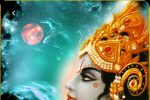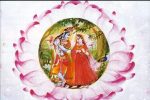NAME 50
* VIŚWÁKARMA- विश्वकर्मा*
Viśva means all pervading and karma means actions. This nāma subtly conveys His omnipresent nature. Brahman alone is omnipresent. When He is omnipresent, He has to be present in all types of actions.
This nāma can also be interpreted to mean that because of His act of creation (referred to as karma here), the universe (viśva) is created. He is the architect of the universe. Viśvakarma also means accomplishing everything, which refers to the Brahman.
Viśvakarmā, son of Brahmā is a celestial architect who builds homes for gods and goddesses.
He, who is the ‘principal universal architect’ – the creator of the world(s), the “divine engineer” of the world. Viśvakarmā विश्वकर्मा
In the light of the above and placing the name Viśwákarma in context, we can conclude that the Supreme being is the ‘architect‘ who imagines, conceptualizes, and crafts the “blueprint,” is the “builder‘ as well as the ‘building‘ itself!
Further, this name also reminds us that it is we who create our own reality – The world appears to us as we see it and as we relate to it. The change we want to see in the world can only be possible by changing from the “inside-out” and for that to happen each one of us has to allow the Viśwákarma within us to flower and express himself/herself to his/her fullest creative potential.
Viśvaṃ karma yasyasaḥ He whose creation is the universe. Or the universe whose action (creation) it is. Viśvaṃ karma vicitraprakāranirmāṇaśaktiḥyasya He who has the power of creating the wonderful manifold. By His similarity to Tvaṣṭa, the celestial architect known as Viśvakarmā.
सोऽहं विश्वसृजं विश्वमविश्वं विश्ववेदसम् ।
Śrīmad Bhāgavata – Canto 8, Chapter 3, verse 26
विश्वात्मानमजं ब्रह्म प्रणतोऽस्मि परं पदम् ॥ २६ ॥
so ’haṁ viśva-sṛjaṁ viśvam
aviśvaṁ viśva-vedasam
viśvātmānam ajaṁ brahma
praṇato ’smi paraṁ padam
He who has created this universe, He who himself is the universe being transcendental to this universe and He who is the only One to be known about since He is the soul of this universe never having taken birth and has been existing eternally – to that supreme consciousness which is The transcendental refuge, I offer my respectful obeisances.
In the Vedas:
Vishwakarma is visualized as the Ultimate reality in the Rig Veda, from whose navel all visible things emanate. The same imagery is seen in Yajurveda purusha sukta, where the divine smith Tvastar originates from Vishwakarma.This concept developed later in the puranic period as Padmanabha. As he is invoked as AJA the unborn , he is the primordial personification of the upanishadic abstract concept Parabrahman.
Vishwakarma’s Architectural Wonders:
Hindu mythology is full of Vishwakarma’s many architectural wonders. Through the four ‘yugas’, he had built several towns and palaces for the gods. In “Satya yuga”, he built the Swarg Loke, or heaven, the abode of the gods and demigods where Lord Indra rules. Vishwakarma then built the ‘Sone ki Lanka’ in “Treta yuga”, the city of Dwarka in “Dwapar yuga”, and Hastinapur in the “Kali yuga”.
५०. ॐ विश्वकर्मणे नमः |
50. OM Viśvakarmaṇe Namaḥ
VIŚWÁKARMA
He who’s Karma (work) has resulted in all that exists (Vishvam) or He whose power of creation is unique and wonderful.
The very creator-of the world-of-objects, of all equipments-of-experiences, and of all experiences in all bosom-is called the Vishwa-Karma. Herein the Infinite Lord is but a Witness of all that is happening and though the experienced world is sustained in Him, He is not involved in the imperfections or mortality, that are happening all around at all times in the Vishwam. “They are in Me, I am not in them”-Gita.
He, who is the ‘principal universal architect‘ – the creator of the world(s), the “divine engineer” of the world
This is a compound word made up of: Viśva and Karma – the universe and action – i.e. “He whose ‘creation’ is this universe“
INTERPRETATION GUIDED BY SANT VANI (WORDS OF SAINTS)
Viśvakarmā
The creator of the universe.
He, who is the ‘principal universal architect‘ – the creator of the world(s), the “divine engineer” of the world.
This is a compound word made up of: Viśva and Karma – the universe and action – i.e. “He whose ‘creation’ is this universe“.
Viśva means sarva. The one, to whom all actions belong, is Viśva- karmā. Whatever karma is done by anyone, be it the devas or human beings, whether in India, Africa – anywhere in the world, all those karmas are His alone, because all are included in Him. Does that mean that one can get away with especially gruesome karma in a court of law, and attribute it to the Lord?
Certainly not. Given free will of a person, it is not absolute, and the karma performed is still in a certain frame of reference. The person is responsible for his actions – good, bad or ugly.
However, the Lord, in the form of the various orders, makes a simple action like speaking a word possible. This whole world, manifest and unmanifest is His accomplishment; hence, He is Viśvakarmā.
Viśva can also be taken to mean big. The Lord’s karmā is not one thing, but the entire world and so His actions are endless. Parameśvara is the sarva-sṛṣṭi-kartā, the creator of everything, sarvasthiti- kartā, the sustainer of everything and sarva-sanhāra- kartā, the withdrawer of everything. Knowing this, the limitations we place on the Lord stand negated.
Every person’s finger print is unique and hence biometric identification is possible. 700,000,000 possibilities account for minor changes in the finger print, all in the area of an inch. Mind boggling, isn’t it? And here we are talking about 7 billion people in this world alone. Vicitranirmāṇa-śaktimattvātvāviśvakarmā–He is Viśva-karmā, because He has this wonderful capacity to create this vicitra-jagat, the world with varieties of things. Everything is so orderly and purposeful.
Viśvakarmā is mentioned in the purāṇas, as the deva-silpi, the architect of the heavens and of great fame. The Lord, being the architect of this entire viśva, is called Viśvakarmā, viśvakarmasādṛśyāt, because He is like the heavenly architect Viśvakarmā. Heavenly architect means the house is not ordinary. The house has fourteen floors made of the fourteen worlds – fourteen spheres of experience, seven up and seven down.
The name Viśwákarma finds mention in the Rig Veda (ऋग्वेदः ṛgvedaḥ) and is thought to be synonymous with the supreme being. Later, we find this Viśwákarma becomes the “divine architect” who through the yugas builds several beautiful palaces and buildings for the Devas, sometimes even the Asuras and other avatārs – for example in Treta-yuga he builds the beautiful “golden” city of Lanka for Rāvaṇa and in the Dwapara-yuga the grand city of Dwaraka for Kṛṣṇa and then also builds Indraprastha for the Pandavas on the orders of Kṛṣṇa. He is also credited with designing, inventing and building several of the wondrous weapons, flying chariots, and divine ornaments across the ages.
Coming back to the use of this name in the context of the ViṣṇuSahasranama: The first name in the ViṣṇuSahasranama is Viśwám – he, who is this Universe. Then comes a string that talks about the Supreme being who is the creator, governor, living principle and the nourishing-essence of all beings:
भूतकृद्भूतभृद्भावोभूतात्माभूतभावनः।
“He who is the initiator of the creative process of the Universe and also the destroyer ” (BHŪTAKṚD:) and “He who is the sustainer, supporter, and real source of deep-strength as the indwelling ‘governor’ of our lives” (BHŪTABHṚT:) is also the supreme and pure indwelling essence that every one seeks as his/her goal in life (BHĀVAḤ:), He lives within each being, as the Ātmā that अंतर्यामी (Antaryāmi), dwelling deep within the cave of the heart and is established there as the ‘living-principle’ is an Aṁșā of the divine – (BHUTĀTMĀ:) and and is the one who nourishes all beings (BHUTABHĀVANAḤ)
In the light of the above and placing the name Viśwákarma in context, we can conclude that the Supreme being is the ‘architect‘ who imagines, conceptualizes, and crafts the “blueprint,” is the “builder‘ as well as the ‘building‘ itself!
At a practical level this name has a deep significance. The supreme being while also being the great architect who designs, builds and guides the universal cosmos is also the “architect-within” (as the BHUTĀTMĀ) and here (within) as that Viśwákarma he designs and guides each Jivātma (that has turned its gaze inwards) towards their ultimate goal of realizing the self-within.
Further, this name also reminds us that it is we who create our own reality – The world appears to us as we see it and as we relate to it. The change we want to see in the world can only be possible by changing from the “inside-out” and for that to happen each one of us has to allow the Viśwákarma within us to flower and express himself/herself to his/her fullest creative potential.
https://os.me/how-did-we-happen
Udupi Kṛṣṇa
The deity is at least 5000 years old and was carved from Śaligrām-shīla by Lord Viṣvakarma himself on the order of Kṛṣṇa when Queen Rukmini (who was none other than Mahālakśmi) desired to worship Him in a childhood form when the latter was angry with her Husband for not allowing her into the rasālīlā.
He later came to Udupi and was installed by ŚrilāMadhwācārya about 800 years ago in the present Udupi Kṛṣṇa Matt and is still being worshipped according to the standards set by him. A few additions were made 400 years later by ŚripādVādirājāTeerthā who installed the deities of Hanumān and Garuda dev (brought from Āyodhya) too.
He is said to be the most innocent looking deity of Kṛṣṇa in the world.
Udupi is called as “DakṣinaDwārkā” (translates to “Dwārkā of south India) and it is said that one reaps the same spiritual benefits by visiting Udupi as they would by visiting Dwārkā.
The lamps were originally lit by ŚrilāMadhwācārya and have never been made to extinguish ever since.
ŚrīCaitanyāMahāprabhu when He visited Udupi collected a flame from these lamps and took it to Vrindāvan.



